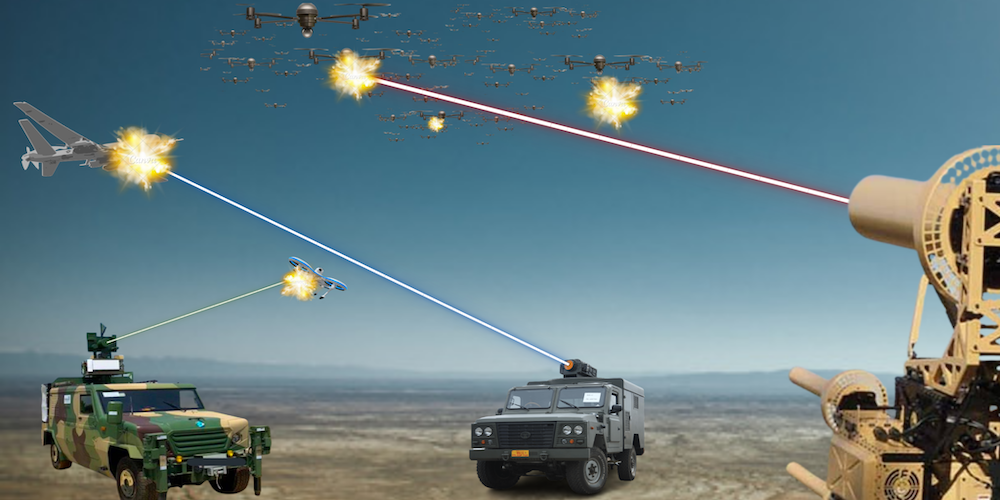Growing anti-Drone Market : India Shows the Way

Counter drone technology, also known as counter-UAS or C-UAS, to detect and/or intercept unmanned aircraft systems while in flight, is gaining potency
The successful testing by Nagpur-based private aerospace sector Solar Defence and Aerospace Limited (SDAL) of the low-cost counter swarm drone system, ‘Bhargavastra’ recently could not have come at a better time when nations are trying hard to deal with the rising menace of drones. Bhargavastra will surely be welcome in the global anti-drone market that is expected to grow from USD 4.48 billion in 2025 to USD 14.51 billion by 2030.
In fact, the success of systems like Bhargavastra is raising many interesting questions in the strategic circles of the world. Are drones now becoming “ No More Potent?” Has “ The End of Drone Supremacy”, as reputed American strategic analyst Mark T. Kimmitt said recently, really begun?
It may be a little premature to answer these questions, but the fact remains that counter drone technology, also known as counter-UAS or C-UAS, to detect and/or intercept unmanned aircraft systems while in flight, is gaining potency.
It is understandable how drones became “ iconic weapons”, given their efficacy in the initial months of the war in Ukraine in 2022 and Hamas’ attack on Israel in 2023. Drones have become more intelligent with AI, enabling them to perform complex tasks autonomously. Operating in swarms, they have increased their effectiveness in reconnaissance, surveillance, and potentially even offensive operations. Advanced targeting systems allow drones to strike specific targets with greater accuracy, minimizing collateral damage. Above all, they are really cheap in the sense that a drone costing 500 U.S. dollars can down a fighter plane or destroy a warship worth millions.
But then the fact remains that the drones are no longer invincible as seen during recent aerial skirmishes between India and Pakistan, Iran-Israel combats and the Russian neutralisation of cheap and plentiful Ukrainian drones. In other words, drones may be near-perfect weapons, but they are becoming vulnerable.
And that, in turn, is in line the eternal truth of warfare over ages – “the battlefield adopts quickly”. For example, one may cite the past dominance of the bombers by recalling here what the then British Prime Minister Stanley Baldwin had proclaimed in 1932. “There is no power on earth that can protect (us) from being bombed. Whatever people may tell him, the bomber will always get through.” However, the subsequent development of early radar detection, interceptor aircraft and anti-aircraft guns quickly became effective countermeasures.
Likewise, anti-drone technology (counter-UAS) has advanced significantly, with various methods developed to detect, track, and neutralize hostile drones. These methods range from physical destruction and electronic warfare techniques to more sophisticated approaches like drone hacking and high-power microwave weapons.
Counter-UAS measures can be categorized into two types of methods, it is said. The first is drone detection and the second in drone mitigation or interception. Radar and RF (Radio Frequency) detection are the technologies used extensively to detect drones. Radar and RF detection can be used in many different types of environments, such as urban or high noise density, to enhance airspace security. RF and radar can be used in tandem to create a multi-layered solution that gives users increased coverage and protection.The most popular drone interception method is drone jamming. Drone jamming works by disrupting the radio frequency link between the drone and its operator.
UAS mitigation countermeasure technology falls into two broad categories – Non-Kinetic: Controlling the drone; and Kinetic: Destroying the drone with a physical attack.
Non-Kinetic drone countermeasures are also referred to as “soft kills.” Soft kill technology includes jammers, spoofers, drone guns. This could be any technology that involves the interruption of signals between the drone and the controller or intercepting the signals to take over pilot responsibility while the drone is in flight.
Kinetic countermeasures are referred to as “hard kills.” Hard kill technology encompasses projectile weapons that physically damage the drone or knock it to the ground. Kinetic methods could include nets, bullets, missiles, or another drone.
Reportedly, the Israeli defense company Rafael has further empowered its Iron Beam- M system, Israel’s main laser-defense architecture, to work in tandem with the kinetic interceptor-based Iron Dome. It has developed the Lite Beam, which is a 10-kW class high energy laser weapon system (HELWS), for countering a wide range of low altitude aerial threats including small UAVs and swarms of drones alongside ground-based threats. It is designed for light 4×4 vehicles as well as for 6×6, 8×8, and tracked armored fighting vehicles. The weapon focuses intense heat on a coin-sized spot, neutralizing up to 10 targets simultaneously at ranges of up to a few kilometers, according to Rafael.
Over all, Israel, a major target of drone attacks from its adversaries in the Middle East, has been able to develop a series of effective anti-drone war efforts that include:
• Multi-Layered Defense: Israel utilizes a multi-layered defense strategy, combining the Iron Dome (short-range), David’s Sling (medium-range), and Arrow systems (long-range) to intercept a wide range of threats, including drones.

• Drone-Specific Technologies: Israel is developing and deploying advanced counter-drone technologies, including:
– Laser-based interception systems like Iron Beam, designed to neutralize drones more cost-effectively than missiles.
– Electronic warfare systems that can jam drone signals or even hijack them, redirecting them or forcing them to land.
– Specialized radar and sensor fusion systems to better detect and track smaller, slower drones.
• AI and Machine Learning: Artificial intelligence is being integrated into drone defense systems to enhance threat classification, assist human operators, and automate target recognition.
• International Collaboration: Israel collaborates with allies like the United States in developing and acquiring advanced counter-drone technologies.
• Operational Adaptation: The Israeli military continuously refines its strategies and tactics based on analysis of enemy drone attacks and experience from conflicts like the war in Ukraine.
According to a latest report on July 2, the U.S. Department of Defense is standing up a joint interagency task force to tackle drone threats. “We recently did a session with the secretary of defense and we are going to stand up a joint interagency task force”, said Gen. James Mingus, vice chief of staff of the Army.
Mingus equated the C-UAS challenge today to the effort to counter improvised explosive devices during the Global War on Terror. It is said that when insurgents began fighting U.S. troops in Afghanistan and Iraq with remotely controlled roadside bombs, the U.S. was able to catalyze a joint and interagency effort and mobilized with great speed to produce Mine-Resistant Ambush Protected Vehicles, which saved countless lives.
Incidentally, in its budget request this year, the U.S. Army has sought to add a new agile line for C-UAS, along with UAS and electronic warfare, to be able to keep pace with emerging technologies and changing battlefields.
As noted at the outset, India’s private aerospace sector Solar Defence and Aerospace Limited (SDAL), based in Nagpur, has successfully tested the new low-cost counter swarm drone system, ‘Bhargavastra’. (SDAL). The counter-drone system was successfully tested at the Seaward Firing Range in Gopalpur on May 14.
Bhargavastra operates in hard kill mode and can detect and eliminate small and incoming drones at distances of up to 2.5 km. Three trials were conducted by SDAL in the presence of senior officials from the Army Air Defence. Two trials involved firing one rocket each, while the third trial fired two rockets in salvo mode within two seconds. All four rockets performed as expected and met the required launch parameters.
Bhargavastra is said to be using unguided micro-rockets as the first layer of defence to neutralise drone swarms within a lethal radius of 20 metres. A guided micro-missile, tested earlier, serves as the second layer for precise neutralisation. The system is designed for deployment across diverse terrains, including high-altitude regions above 5,000 metres.
The cost-effective Bhargavastra is modular and can include an additional soft-kill layer for jamming and spoofing, providing an integrated shield for all branches of the armed forces. The sensors and shooter can be configured as per user requirements for layered air defence coverage.
The system integrates with existing network-centric warfare infrastructure. Its Command-and-Control Centre features advanced C4I technology. The radar can detect small aerial threats from 6 to 10 km away, while the Electro-Optical Infrared sensor suite ensures precise identification of low radar cross-section targets.
According to its developers, Bhargavastra represents a significant step in counter-drone technology. Its open-source architecture and multi-layered, cost-effective design with swarm neutralisation capabilities are unique globally.
What all these developments suggest is that Counter-UAS technology is rapidly emerging and evolving as the mass adoption of drones takes place. But this does not necessarily mean the drone -threats are going to wither away. They, too, are evolving. The point is, and here Kimmitt makes a sense, when he says that “like so many other wonder weapons once thought revolutionary and invincible, drone supremacy has already had its moment on the modern battlefield”.
No wonder why the global anti-drone market is expected to grow from USD 4.48 billion in 2025 to USD 14.51 billion by 2030, representing a CAGR (compound annual growth rate) of 26.5%, according to a recent study).


